22 Common Backyard Birds in Mississippi (With Pictures)
Last Updated on
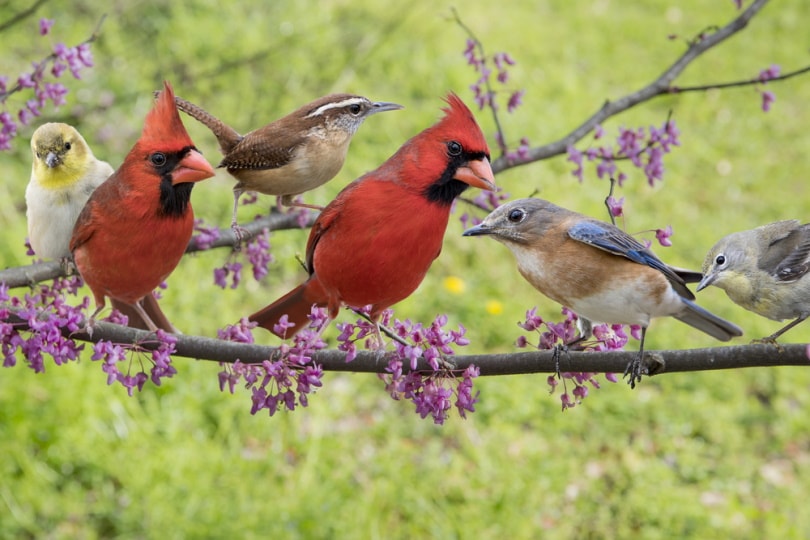
Mississippi is home to over 400 types of birds, with the most commonly seen bird being the Northern Cardinal. So, whether you’re a habitual birdwatcher or enjoy the occasional backyard sighting, you’d want to know about the most common backyard birds you’re likely to see in Mississippi.
Fortunately, Mississippi birds love visiting the residents’ backyards. So, if you’re wondering what kinds of birds you might encounter while living in Mississippi, here’s a list of the most common backyard birds in the state, along with some pictures to help you identify them.

The 22 Common Backyard Birds in Mississippi
Here are the top 22 Mississippi bird species you can find in your backyard. We’ve added their names, pictures, and distinguishing features to help you identify them.
1. Common Yellowthroat
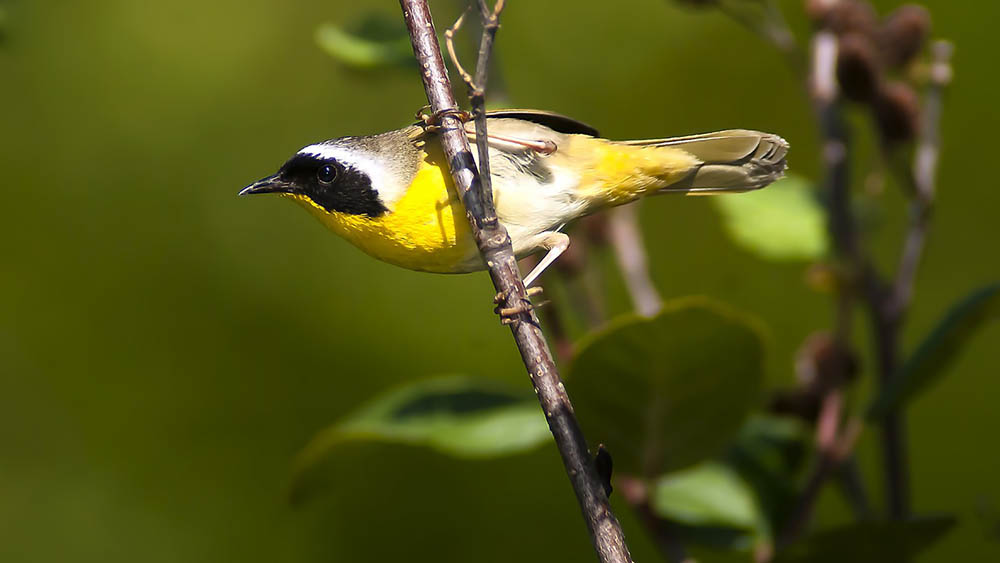
| Scientific Name | Geothlypis trichas |
| Length | 4.3–5.1 inches |
| Wingspan | 5.9–7.5 inches |
The Common Yellowthroat is a small warbler. Adult males have olive-green upper parts, a yellow throat, and breasts with a black mask across the eyes.
Females look similar to males but lack a black mask. Their breeding habitat is in marshes with thick vegetation in North America, east of the Rockies.
You’re likely to find these Mississippi songbirds in tree branches. They also come to the ground looking for food. Their preferred food includes berries, nuts, green fruits, and seeds. They also feed on small insects, such as beetles, spiders, and caterpillars.
2. Northern Cardinal
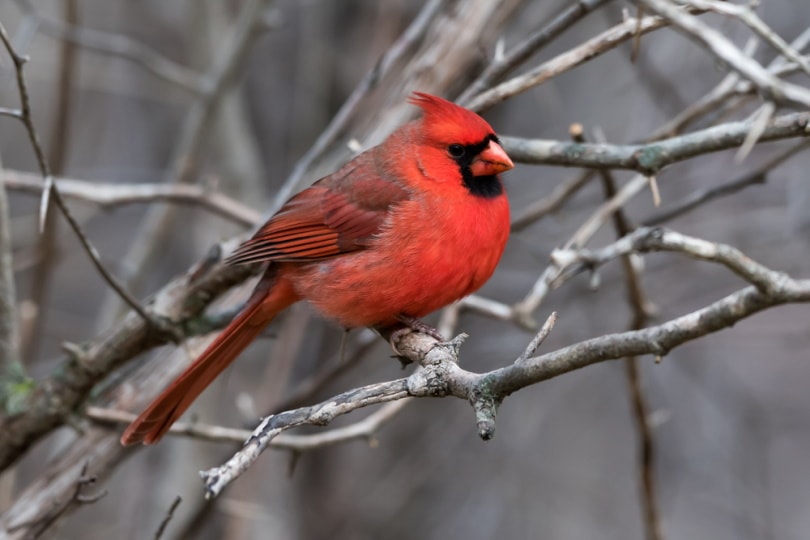
| Scientific Name | Cardinalis cardinalis |
| Length | 8.3–9.1 inches |
| Wingspan | 9.8–12.2 inches |
The Northern Cardinal is a North American bird in the genus Cardinalis. It is also known colloquially as the redbird or Common Cardinal.
It can be found in Southern Canada, through the Eastern United States from Maine to Texas, and throughout Mexico. It is found in woodlands, gardens, shrublands, and swamps.
Male cardinals have a brilliant red color with a black face and a reddish bill. Females have a pale brown color with a reddish tinge in their crest, tail, and wings.
You’ll find northern cardinals in shrubs and trees. They’re also found on the ground, where they roam in pairs. Besides backyards, you can also find these birds in parks, shrubby forest edges, and woodlots. They make their nests in vines and dense shrub tangles.
3. Tufted Titmouse

| Scientific Name | Baeolophus bicolor |
| Length | 5.5–6.3 inches |
| Wingspan | 7.9–10.2 inches |
The tufted titmouse is a small songbird with gray upper parts and pale underparts. The head has a black cap and crest, white eyebrows, and dark eyes.
The bird is found in woodlands in Eastern North America, making cup-shaped nests in trees. It feeds on insects, seeds, and berries.
The Tufted Titmouse is a nonmigratory bird that ranges from Southern Canada to Northern Florida. It is a year-round resident in most of its range. The bird’s habitat includes woodlands, forests, and suburban gardens.
4. Blue Jay
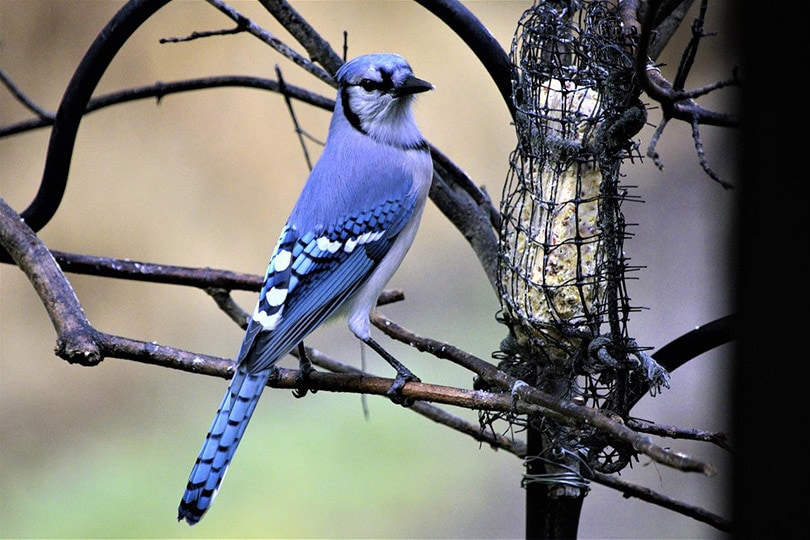
| Scientific Name | Cyanocitta cristata |
| Length | 9.8–11.8 inches |
| Wingspan | 13.4–16.9 inches |
Blue Jays are relatively common birds in North America. They are known for their beautiful blue plumage and loud calls. They usually fly across open areas during migration season.
You’ll find Blue Jays on the edges of forests. They love to feed on acorns and are commonly found near woodlots, cities, parks, and forests.
5. Northern Mockingbird
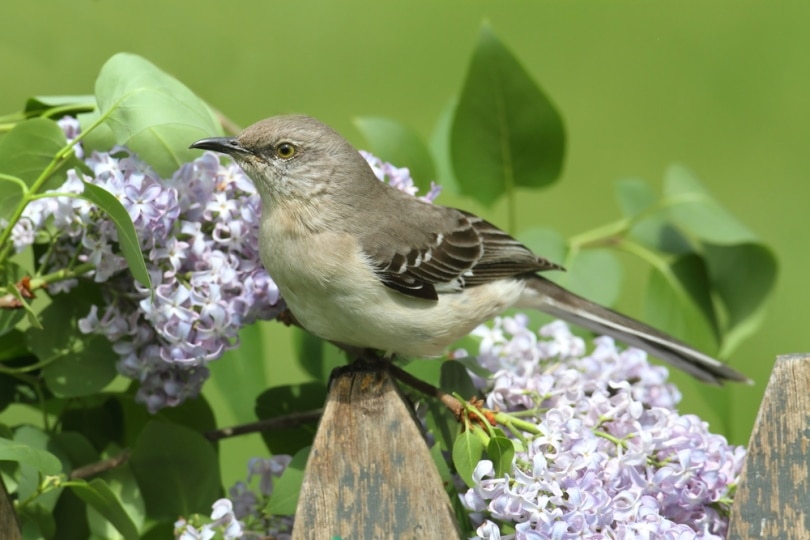
| Scientific Name | Mimus polyglottos |
| Length | 8.3–10.2 inches |
| Wingspan | 12.2–13.8 inches |
Northern Mockingbirds have gray-brown upperparts and a gray breast. The belly and under tail coverts are white. There are two color forms of the Northern Mockingbird: gray-brown and rufous. The rufous form is more common in the southern part of the range. Meanwhile, juveniles have heavily-streaked upper parts.
You’d see these mockingbirds on fences, high vegetation, and telephone wires. But, besides backyards, they also like to appear in parks, open lands, towns, suburbs, and forest edges.
6. Mourning Dove
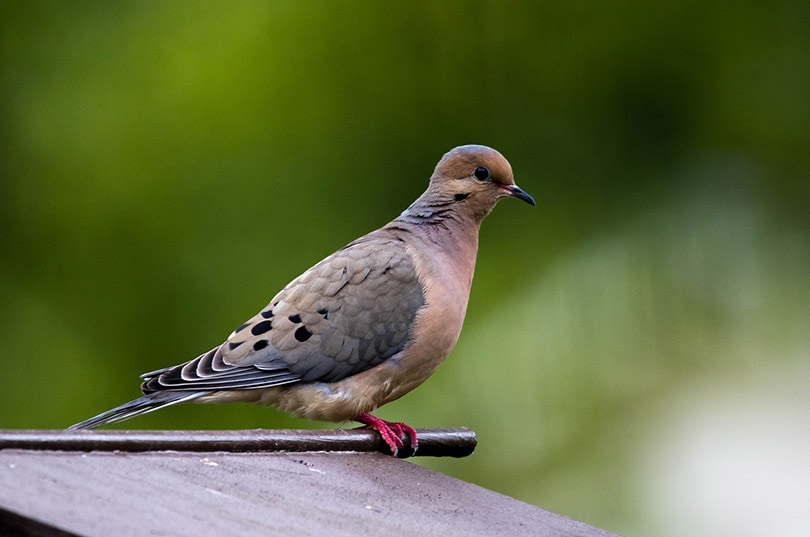
| Scientific Name | Zenaida macroura |
| Length | 9.1-–3.4 inches |
| Wingspan | 17.7 inches |
The mourning doves are one of the most commonly seen brown birds in Mississippi. They have black spots on the wings and a long, pointed tail. Mourning Doves are named for their soft, cooing call, which sounds like they are mourning.
They mainly eat seeds and fruits and live in open areas with nearby trees. You can find them in your backyard, perched on telephone wires, or on bare ground.
7. Carolina Chickadee
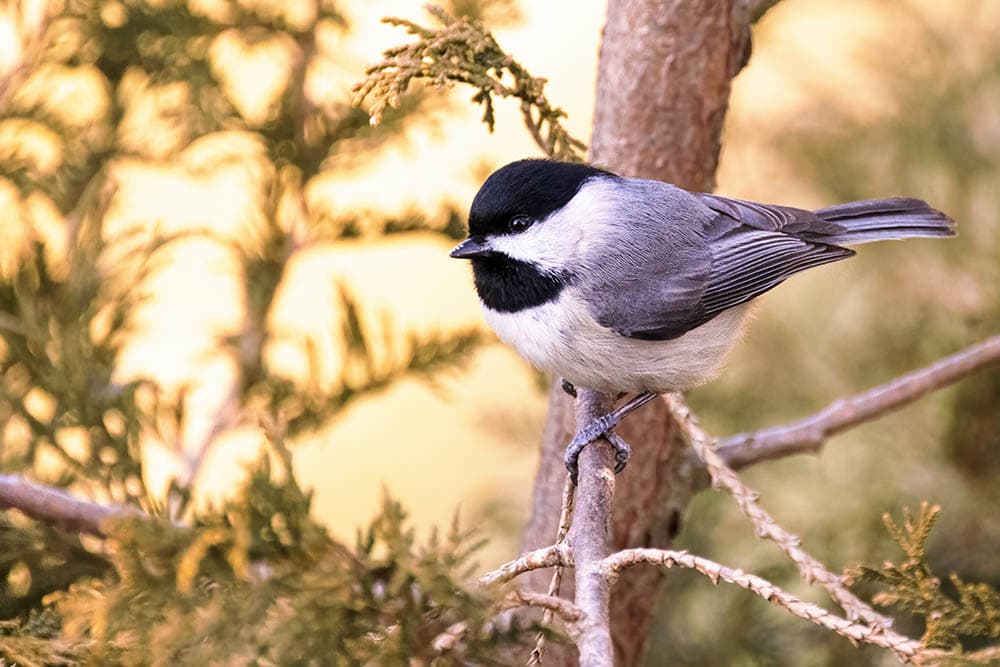
| Scientific Name | Poecile carolinensis |
| Length | 3.9–4.7 inches |
| Wingspan | 5.9–7.9 inches |
The Carolina Chickadee is a small songbird that is a member of the tit family. This bird is found in the Eastern United States from Maine to Georgia and west to Missouri and Arkansas.
The bird has a black cap and bib with a white face and throat. The upper parts are grayish-brown, and the underparts are pale gray.
Chickadees are commonly found on large trees and in suburban yards. They are typically very acrobatic and can hang upside down from branches. These birds eat small insects, spiders, and seeds.
8. Eastern Bluebird
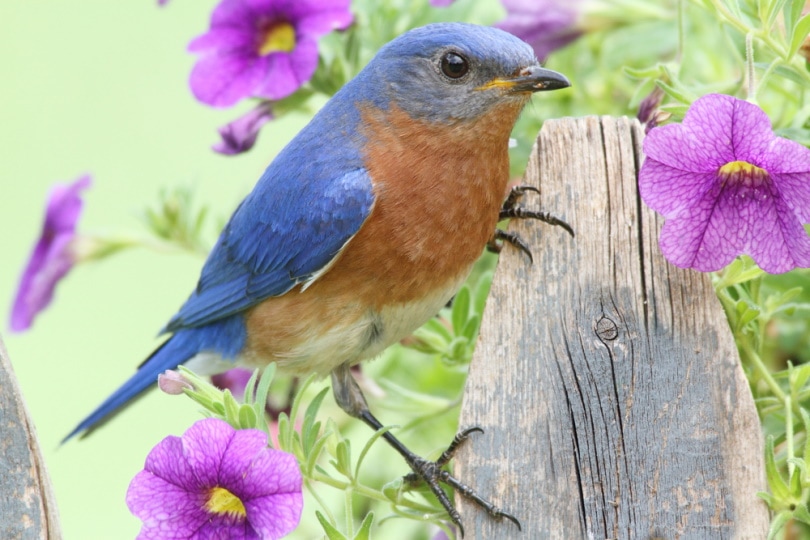
| Scientific Name | Sialia sialis |
| Length | 6.3–8.3 inches |
| Wingspan | 9.8–12.6 inches |
The Eastern Bluebirds have vivid colors that make them easy to spot. The male has a blue back, wings, tail, and a rusty-red throat and breast. However, if you look at them from a distance, they appear gray-brown.
Females have grayish upper parts and blue wings. The breast has an orange-brown color. Both sexes have white bellies and dark eyes.
Bluebirds are commonly seen on posts, wires, and low-hanging branches, where they scour for their prey. They feed on insects and berries.
Since they prefer being closed to trees with nest holes, they are now a common sight on golf courses and field edges where nest boxes are abundantly present. You can easily spot them by their rounded head, alert posture, and plump body.
9. Carolina Wren

| Scientific Name | Thryothorus ludovicianus |
| Length | 4.7–5.5 inches |
| Wingspan | 11.4 inches |
The Carolina Wren is a chunky bird with a short tail that is often cocked. It has a rusty brown back, wings, and tail, while the underparts are white with heavy rust-brown streaks on the sides.
The head is buff gray with a dark cap and a white supercilium. There is a small black bill, and the legs are pinkish brown. These birds like to explore garages, yards, and woodpiles.
You might even find a Carolina Wren nest in your backyard. Since they are Mississippi songbirds, Wrens constantly sing to defend their area. They have a knack for chasing intruders off with this aggressive scolding and singing.
10. Blue-Gray Gnatcatcher

| Scientific Name | Polioptila caerulea |
| Length | 3.9–4.3 inches |
| Wingspan | 6.3 inches |
The Blue-Gray Gnatcatcher is one of the most commonly sighted Mississippi songbirds, known for its beautiful blue-gray plumage. The birds are somewhat similar to Black-Tailed Gnatcatchers. However, they do not have the characteristic black tails like their black-tailed family members.
The upper part of this blue-gray bird is dark blue, while the underside is gray. You’ll find these birds on small trees and bushes close to the water.
Blue-Gray Gnatcatchers eat small insects, such as beetles, flies, and caterpillars. They also eat insect larvae and eggs. Sometimes, they also come to bird feeders to feed. So, if you have one in your backyard, it might attract a Gnatcatcher.
11. Red-Bellied Woodpecker
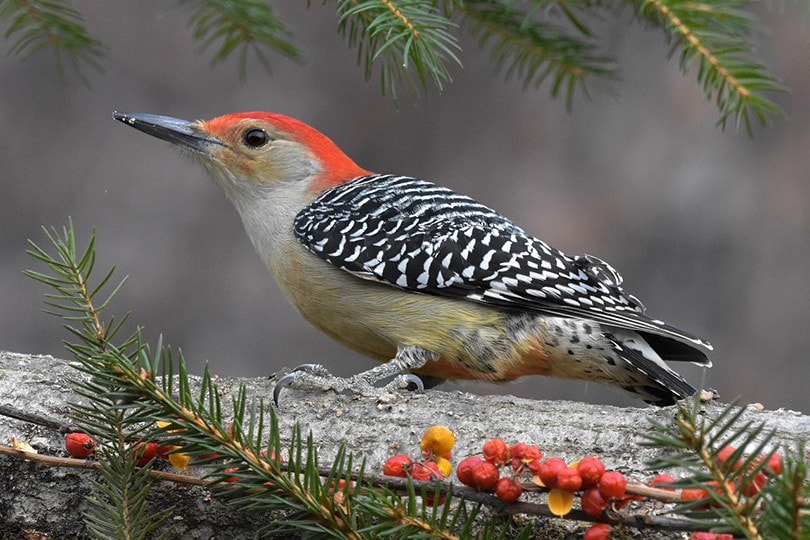
| Scientific Name | Melanerpes carolinus |
| Length | 9.4 in |
| Wingspan | 13.0–16.5 in |
The Red-Bellied Woodpecker is a medium-sized woodpecker with a dull gray back, wings, and tail. The head is black with a red cap, nape, and lines down the side of the neck to the breast.
There is heavy white spotting on the face and neck. The belly and sides are pale pink. Females have a smaller red cap than males.
These woodpeckers hitch along trunks and branches of trees. They pick at the surface of the bark rather than drilling. Like most other woodpeckers, the Red-Bellied Woodpeckers also have an undulating flight pattern.
12. Purple Martin

| Scientific Name | Progne subis |
| Length | 7.5–7.9 inches |
| Wingspan | 15.3–16.1 inches |
The Purple Martin is a large swallow bird. It has a dark, blue-purple plumage and a forked tail. The bird is one of the largest members of the swallow family in North America.
It breeds in open habitats, typically near water, and feeds on insects. Adult male Purple Martins have brown-black tails and wings. The rest of their body is a dark blue-purple color.
Meanwhile, females have a duller color with a white lower belly and gray chest and head. Purple Martins feed on aerial insects as they have a midair feeding pattern. You might have difficulty spotting them since they fly and feed at higher altitudes.
13. American Crow
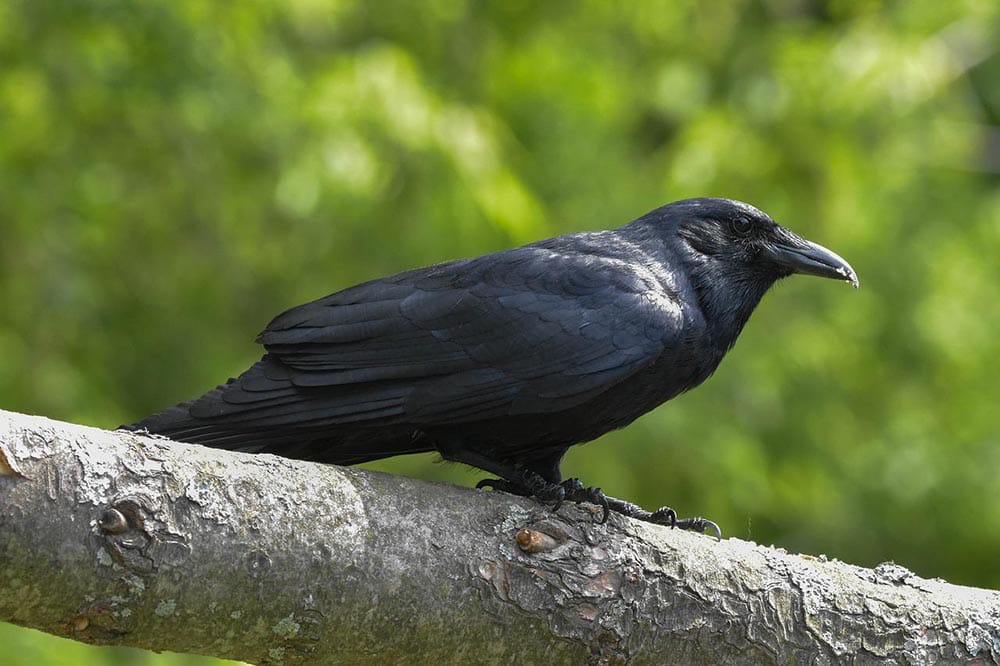
| Scientific Name | Corvus brachyrhynchos |
| Length | 15.8–20.9 inches |
| Wingspan | 33.5–39.4 inches |
The American crow has a black body with black feathers. The bill is also black, as are the legs and feet. There is no sexual dimorphism in plumage, but the male is usually larger than the female. Immature birds have browner plumage than adults.
The American Crow is a member of the genus Corvus, including ravens, jackdaws, and rooks. The species is not as widely distributed as some of its relatives—it is confined to North America.
Since crows are social birds, they form large flocks. So, you might see a flock of American crows in your backyard if they find discarded food there.
14. Eastern Towhee

| Scientific Name | Pipilo erythrophthalmus |
| Length | 6.8–8.2 inches |
| Wingspan | 7.9–11.0 inches |
Eastern Towhees are small, sparrow-like birds. They have a black head and back with a rufous (reddish-brown) breast. The wings are black with white bars, and the tail is long and black.
Female Towhees have a brown throat and heat with rufous sides. Meanwhile, male Towhees have a black head and throat. They also have a white belly and rufous sides. You can spot them by the while corners of their tails.
Towhees are found in woodlands and thickets, usually near the ground. They eat insects and other small animals, spending time in thick bushes and shrubs.
15. Downy Woodpecker

| Scientific Name | Picoides pubescens |
| Length | 5.5–6.7 inches |
| Wingspan | 9.8–11.8 inches |
The Downy Woodpecker is a small woodpecker found in North America. It is the most common woodpecker in the United States and is often seen drumming on tree trunks or foraging for insects under the bark.
The downy woodpecker is a member of the genus Picoides, containing small to medium-sized woodpeckers with stout bodies. These birds make a lot of noise as they have a shrill call sound. Their constant drumming amplifies the noise on the trees where they perch.
Downy woodpeckers are common in deciduous trees and weedy edges. Along with backyards, they also make an appearance in vacant lots and city parks.
16. Common Grackle
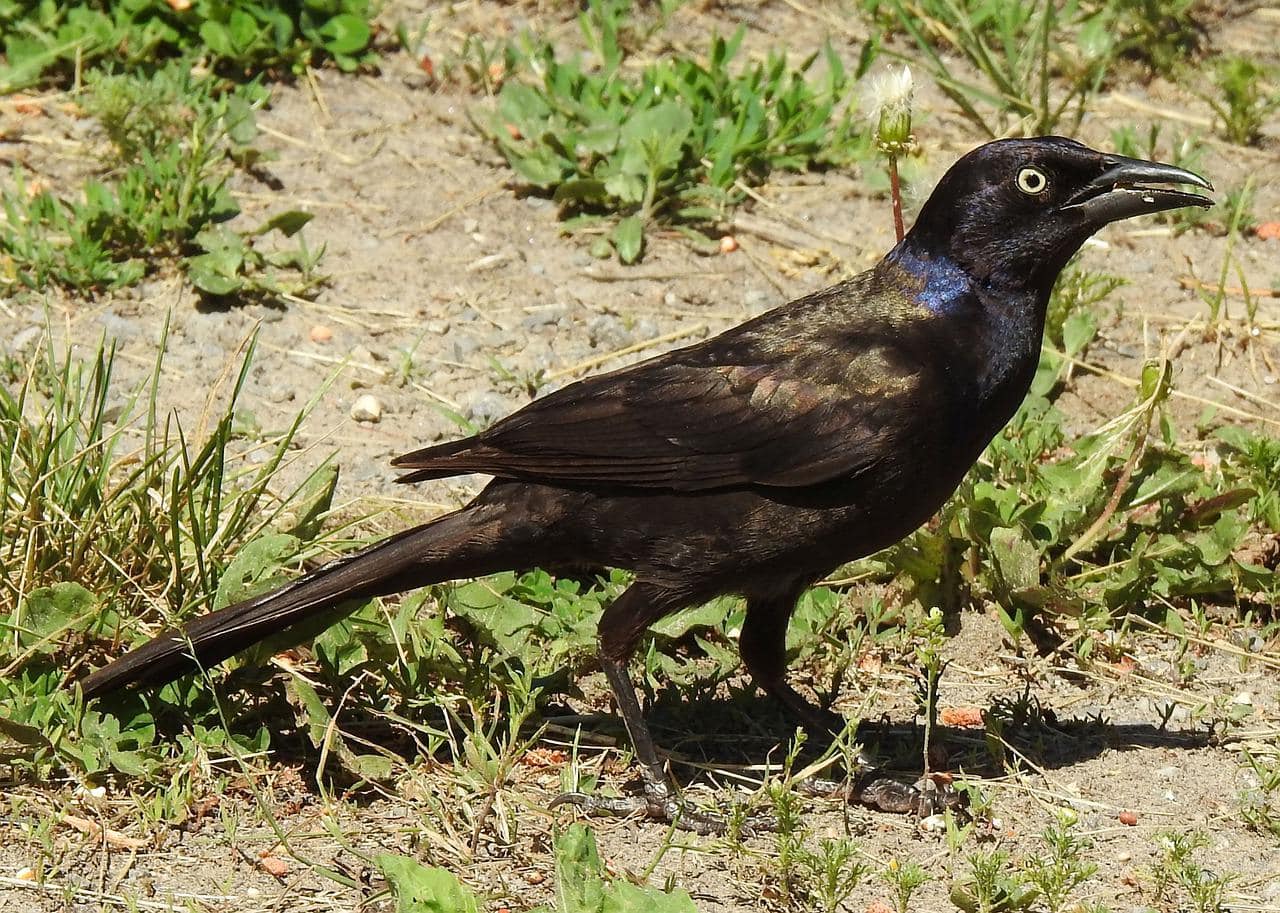
| Scientific Name | Quiscalus quiscula |
| Length | 11.0–13.4 inches |
| Wingspan | 14.2–18.1 inches |
The Common Grackle is one of the large-sized Mississippi songbirds with white eyes and a long, stout bill. The male Common Grackle has a greenish-black head, neck, and back. Their underparts are yellow to orange.
The wings are black with iridescent purple and green feathers. The tail is long and pointed. The female Common Grackle is similar to the male but is less glossy than its male counterparts.
The bird’s song is a guttural squeak with a clear, high-pitched whistle. Common Grackles sit on telephone lines and trees, where they keep chattering with their other grackles.
They are common in feedlots, suburban laws, city parks, and agricultural fields. You can also find them in marshes, meadows, and woodlands.
17. American Robin
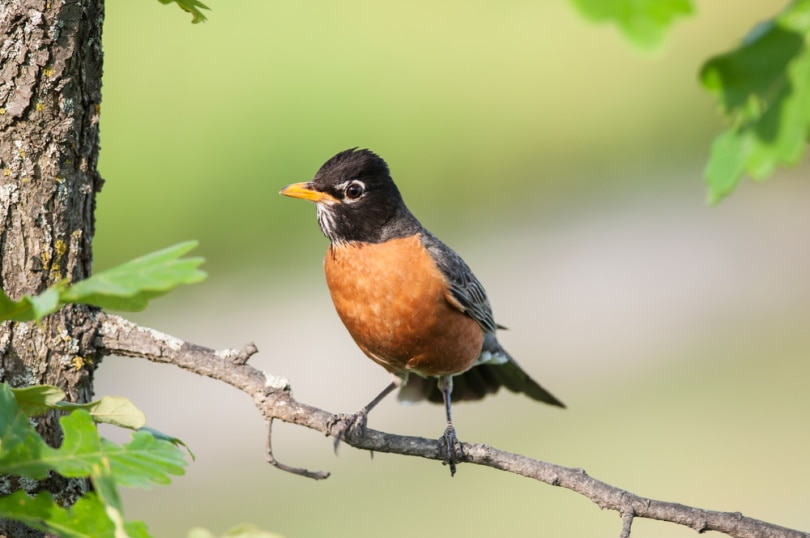
| Scientific Name | Turdus migratorius |
| Length | 7.9–11.0 inches |
| Wingspan | 12.2–15.8 inches |
The adult male American Robin has dark gray upperparts and head, bright red breast, and a white belly. The adult female is similar in appearance to the male, but her plumage is more subdued.
Juveniles have browner upperparts and lack the red breast of the adults. American Robins are industrious birds, which means that they are always on the move looking for food. Their diet consists of earthworms, insects, and berries.
American Robins are one of the first birds to sing at dawn, and their song is a familiar sound of spring. They are common year-round residents in much of North America.
18. American Goldfinch
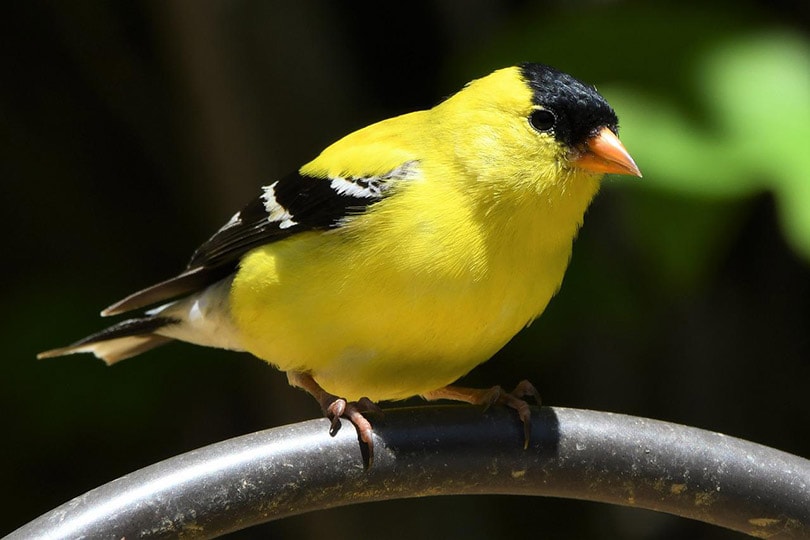
| Scientific Name | Spinus tristis |
| Length | 4.3–5.1 inches |
| Wingspan | 7.5–8.7 inches |
American goldfinches have a light yellow body with black wings and tails. In addition, the male goldfinch has a black cap on its head, while the female goldfinch has a light brown cap.
American goldfinches are found in open woodlands, meadows, and fields across North America. These birds eat seeds and insects. American goldfinches are social birds that often draw attention due to their bouncy flight pattern.
Although their natural habitat is floodplains and weedy fields, you’ll also find them on roadsides and backyards. They also come to bird feeders, mainly during the winter season.
19. Brown Thrasher
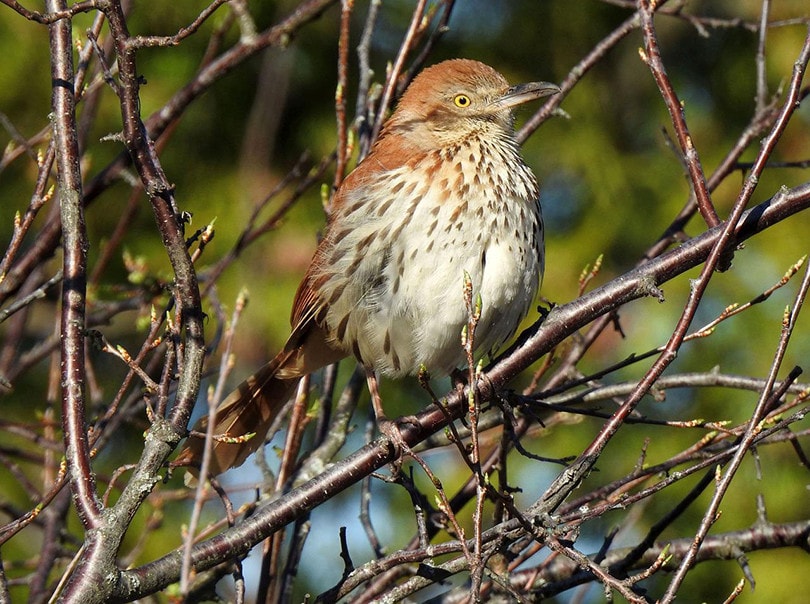
| Scientific Name | Toxostoma rufum |
| Length | 9.1–11.8 inches |
| Wingspan | 11.4–12.6 inches |
Featuring a streaked breast and yellow eyes, Brown Thrashers are some of the most commonly sighted brown birds in Mississippi. They are also one of the state’s largest thrashers, rivaled by the much rarer Long-Billed Thrasher.
Brown Thrashers are found in various habitats, including forests, farmlands, and even backyards, where they can be seen throughout the year.
The Brown Thrasher is noted for its loud, raspy song, which it sings from high perches, such as trees and bushes. The bird will often sing for long periods.
If you’re lucky enough to see a Brown Thrasher up close, you’ll notice that they are interesting birds with many unique behaviors. For example, these birds make a kissing sound, and their song is a combination of other birds’ songs.
20. White-Throated Sparrow
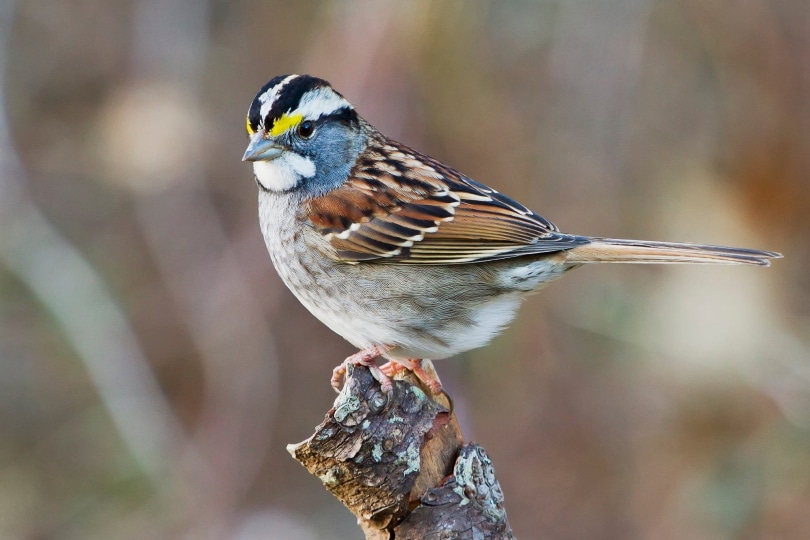
| Scientific Name | Zonotrichia albicollis |
| Length | 6.3–7.1 inches |
| Wingspan | 7.9–9.1 inches |
The White-Throated Sparrow is a small songbird of the Northern Hemisphere. It breeds in North America from Alaska and Newfoundland down to Virginia.
The sparrow gets its name from the white throat patch, which is conspicuous when the bird is singing. The upper parts are brown with heavy streaks, while the underparts are pale with light streaks.
There are two color morphs, one with a tan crown and one with a white crown. The two forms—tan-striped and white-striped—were once considered separate species but are now known to interbreed.
The White-Throated Sparrow is a seedeater and will also consume insects when they are available. It forages on the ground in open areas, often turning over leaves with its bill to find food.
21. Summer Tanager
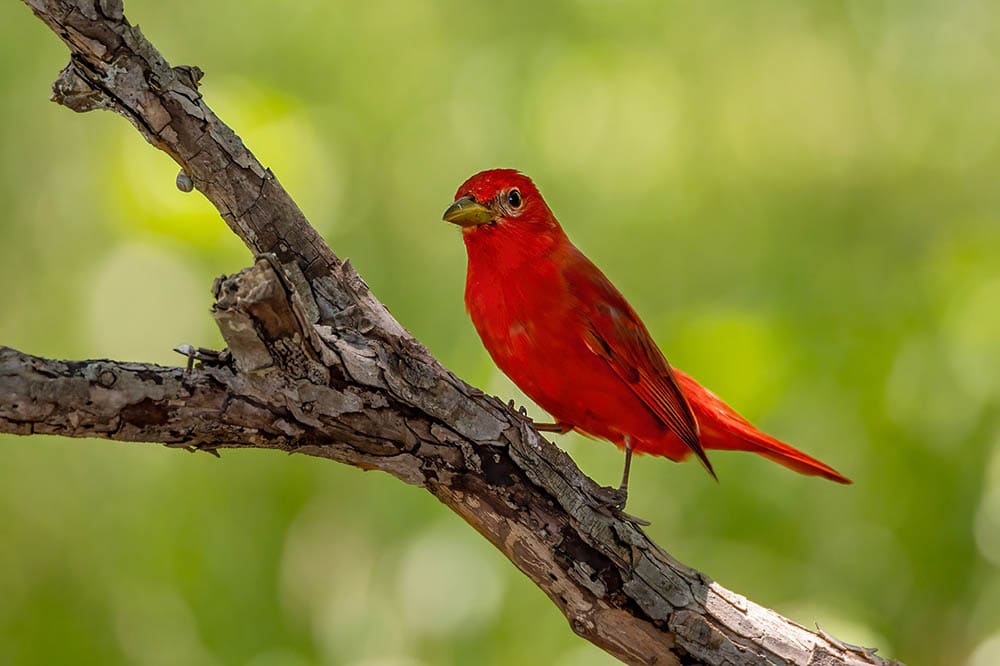
| Scientific Name | Piranga rubra |
| Length | 6.7 inches |
| Wingspan | 11.8 inches |
If you’re interested in seeing red birds in Mississippi, the Summer Tanager is a good option. It’s a medium-sized bird with a strong bill and strong legs.
The male Summer Tanager is all red, while the female is yellowish with greenish wings. These birds are found in open woodlands and forests. They eat insects, berries, and fruits.
You can find them near the Gulf Coast during the breeding season. Look for them in March and April and from August to October. In Mississippi, they’re most often seen in the northern part of the state.
22. Indigo Bunting
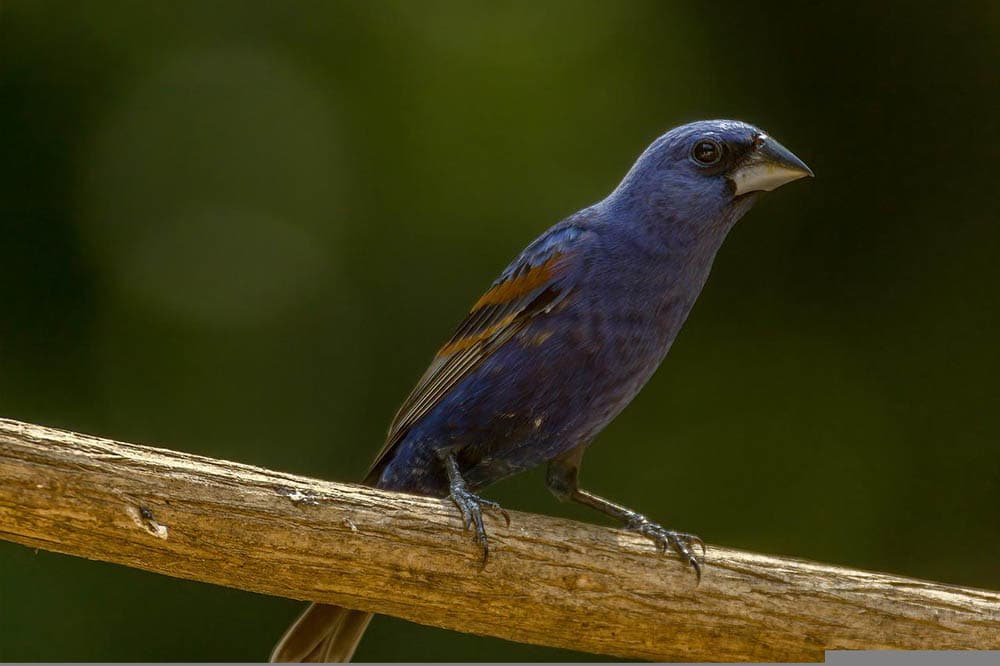
| Scientific Name | Passerina cyanea |
| Length | 4.7–5.1 inches |
| Wingspan | 7.5–8.7 inches |
Indigo Bunting is a seed-eating bird in the genus Passerina. The adult male’s dark blue plumage is distinctive among North American songbirds. The female tends to be duller overall, with grayish-brown upper parts and a light gray breast.
Breeding males have a clear and high-pitched song. These birds are found in bushy and weedy areas, particularly in regions where the forests and fields meet.
They like to stay near overgrown patches, bushy roadsides, and hedgerows. You’ll also find them foraging among grasses and shrubs where they tend to search for seeds.

Common Types of Birds Found in Mississippi Backyards
Mississippi has a variety of birds that can be found in backyards throughout the state. The most common backyard birds include sparrows, finches, cardinals, doves, and jays. Each species has different behaviors and preferences that make them well-suited for living near humans.
Mississippi Songbirds
Songbirds are some of the most common backyard birds in Mississippi. These birds are typically small to medium and have thin, pointed beaks that they use to eat insects.
Many songbirds also have brightly colored feathers, which they use to attract mates. The most common songbirds in Mississippi include sparrows, finches, and robins.
Cardinals
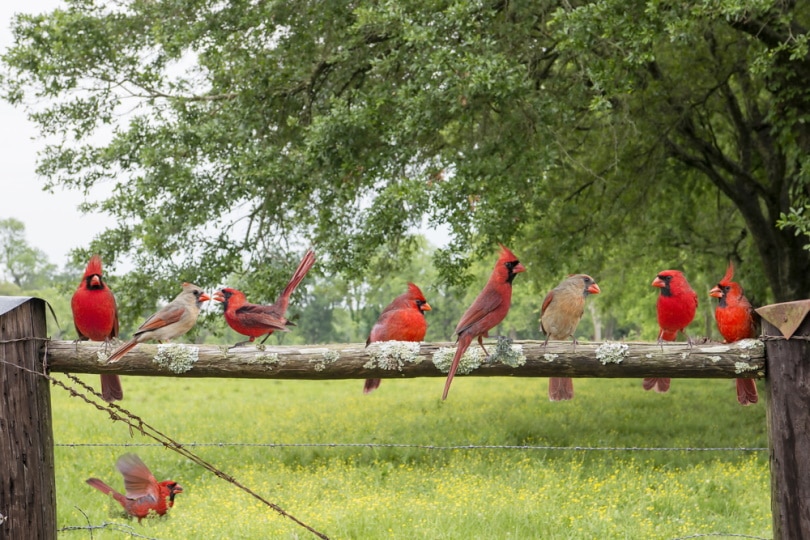
Cardinals are a type of songbird native to the Eastern United States. They are easily recognizable by their bright red feathers and black beaks.
Males and females look similar, but males have a darker plumage than females. Cardinals are social birds that typically live in pairs or small groups.
Doves
Doves are closely related to pigeons. However, they are typically smaller than pigeons and have thinner bodies.
Doves also have longer tails and legs than pigeons. There are two types of doves common in Mississippi: Mourning Doves and Rock Doves.
Mourning Doves get their name from their mournful, cooing call. They are gray and white with a long, tapered tail.
Rock Doves are also known as feral pigeons. They are typically gray with two black bars on their wings. Rock Doves live in urban areas and are often considered to be pests.

Conclusion
Whether you’re looking for red birds in Mississippi or want to be mesmerized by the calls of songbirds, this guide has covered most birds you’ll find in your backyards. You can now spot these birds and learn about their unique behaviors.
The best way to welcome these birds to your backyards is to have brightly colored bird feeders for each type of bird. It would help if you kept your backyard clean and free from debris, so the birds have a comfortable place to forage.
Featured Image Credit: Bonnie Taylor Barry, Shutterstock
Table of Contents
- The 22 Common Backyard Birds in Mississippi
- 1. Common Yellowthroat
- 2. Northern Cardinal
- 3. Tufted Titmouse
- 4. Blue Jay
- 5. Northern Mockingbird
- 6. Mourning Dove
- 7. Carolina Chickadee
- 8. Eastern Bluebird
- 9. Carolina Wren
- 10. Blue-Gray Gnatcatcher
- 11. Red-Bellied Woodpecker
- 12. Purple Martin
- 13. American Crow
- 14. Eastern Towhee
- 15. Downy Woodpecker
- 16. Common Grackle
- 17. American Robin
- 18. American Goldfinch
- 19. Brown Thrasher
- 20. White-Throated Sparrow
- 21. Summer Tanager
- 22. Indigo Bunting
- Common Types of Birds Found in Mississippi Backyards
- Conclusion
About the Author Jeff Weishaupt
Jeff is a tech professional by day, writer, and amateur photographer by night. He's had the privilege of leading software teams for startups to the Fortune 100 over the past two decades. He currently works in the data privacy space. Jeff's amateur photography interests started in 2008 when he got his first DSLR camera, the Canon Rebel. Since then, he's taken tens of thousands of photos. His favorite handheld camera these days is his Google Pixel 6 XL. He loves taking photos of nature and his kids. In 2016, he bought his first drone, the Mavic Pro. Taking photos from the air is an amazing perspective, and he loves to take his drone while traveling.
Related Articles:
Monocular vs Telescope: Differences Explained (With Pictures)
10 Types of Hummingbirds in Arkansas (With Pictures)
8 Types of Hummingbirds in Nebraska (With Pictures)
5 Types of Hummingbirds in Idaho (With Pictures)
3 Types of Hummingbirds in Mississippi (With Pictures)
8 Types of Hummingbirds in Kansas (With Pictures)
5 Types of Hummingbirds in West Virginia (With Pictures)
5 Types of Hummingbirds in Ohio (With Pictures)
